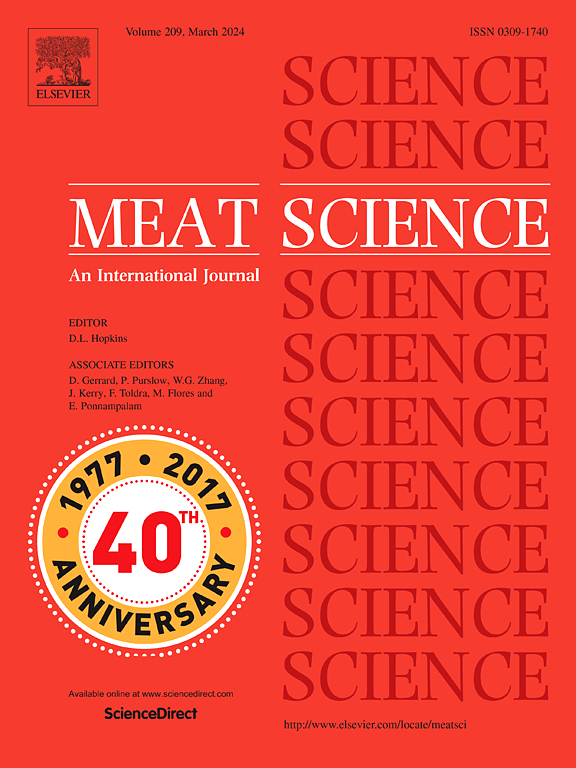利用核磁共振 (NMR) 技术快速无损地测量澳大利亚牛肉和羊肉的肌内脂肪。
IF 7.1
1区 农林科学
Q1 Agricultural and Biological Sciences
引用次数: 0
摘要
核磁共振 (NMR) 是对肉类进行非破坏性分析的绝佳技术,因为它精度高、响应线性、随时间漂移小,无需重新校准。此外,单面核磁共振设备具有开放式几何结构,可对较大样品的子部分进行测量,而无需采集子样品。在此,我们展示了台式设备的长期再现性和单面 NMR 设备的实用性。在原始模型创建数年后,我们验证了商用处理器剔骨室中羔羊肌肉内脂肪 (IMF%) NMR 测量的长期重现性。我们假设 NMR IMF% 模型将在独立验证中保持精确性和准确性。羊肉 IMF 预测的均方根 (RMS) 误差为 0.79%。参考测量值与预测 IMF% 之间的 R2 为 0.74,化学 IMF% 与 NMR 预测值的斜率为 0.989,偏差为 0.53 % IMF%。在第二个例子中,我们展示了可以在商业加工传送带上测量高价值牛肉带的 IMF% 值,并在不损坏产品的情况下返回。我们假设商业原型单面 NMR 系统可以预测牛肉胸长肌和腰长肌的 IMF%。相关性均方根误差为 1.58 % IMF%,R2 为 0.97。单侧 NMR 设备具有长期稳定性、高准确性和无损性,是红肉行业应用的理想选择,因为 IMF% 会影响产品价值。本文章由计算机程序翻译,如有差异,请以英文原文为准。
Fast non-destructive measurement of intramuscular fat in Australian beef and lamb using nuclear magnetic resonance (NMR) technologies
Nuclear magnetic resonance (NMR) is an excellent technique for non-destructive analysis of meat because it has high accuracy, a linear response, and insignificant drift over time, which removes the need for recalibration. Furthermore, single-side NMR devices have open geometries that enable measurements of subsections of larger samples without taking sub-samples. Here we demonstrated long-term reproducibility in a benchtop device and the utility of a single-sided NMR device. We validated long-term reproducibility of NMR measurements of lamb intramuscular fat (IMF%) in a commercial processor boning room years after the original model was created. It was hypothesised that the NMR IMF% model would retain precision and accuracy on independent validation. The root mean squared (RMS) error of prediction of lamb IMF was 0.79 %. The R2 between reference measurements, predicted IMF% was 0.74, the slope of the chemical IMF% vs NMR predictions was 0.989, and the bias was 0.53 % IMF%. In the second example, we showed that IMF% measurements of high value beef striploins could be measured off a commercial processing belt and returned without damaging the product. It was hypothesised that a commercial prototype single-sided NMR system would predict IMF% in beef M. longissimus thoracis et lumborum. Here the RMS error of the correlation was 1.58 % IMF% and R2 was 0.97. The long-term stability, high accuracy, and nondestructive nature make unilateral NMR devices ideal for applications in the red meat industry where IMF% contributes to product value.
求助全文
通过发布文献求助,成功后即可免费获取论文全文。
去求助
来源期刊

Meat Science
工程技术-食品科技
CiteScore
12.60
自引率
9.90%
发文量
282
审稿时长
60 days
期刊介绍:
The aim of Meat Science is to serve as a suitable platform for the dissemination of interdisciplinary and international knowledge on all factors influencing the properties of meat. While the journal primarily focuses on the flesh of mammals, contributions related to poultry will be considered if they enhance the overall understanding of the relationship between muscle nature and meat quality post mortem. Additionally, papers on large birds (e.g., emus, ostriches) as well as wild-captured mammals and crocodiles will be welcomed.
 求助内容:
求助内容: 应助结果提醒方式:
应助结果提醒方式:


